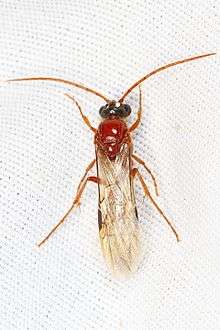Brachycistidinae
| Brachycistidinae | |
|---|---|
 | |
| Tiphiid Wasp species of the Brachycistidinae subfamily, from the Great Basin National Park, Baker, Nevada | |
| Scientific classification | |
| Kingdom: | Animalia |
| Clade: | Euarthropoda |
| Class: | Insecta |
| Order: | Hymenoptera |
| Family: | Tiphiidae |
| Subfamily: | Brachycistidinae Kimsey 1991[1] |
| Genera | |
|
See text | |
Brachycistidinae is a subfamily of the flower wasp family Tiphiidae which contains 10 genera and 85 species,[2] and which is confined to the Nearctic Zoogegraphic region.[1]
Distinguishing Characters
The wasps in the subfamily Brachycistidinae are distinguished from the subfamily Tiphiinae by having simple claws and the lack of an epicnemial suture, while the tegulae do not cover the axillary sclerites of the forewing.[3] These wasps demonstrate extreme sexual dimorphism the females resemble ants and are wingless while the males are winged and nocturnal. These extreme differences between the sexes have led to instances where the males and females are described as separate species, known as "dual-taxonomy", and later work shows the two "species" to be synonymous.[2] The identification of both sexes as a single species is often only achieved when they are collected in copula.[4]
Biology
The female wasps of the family Tiphiidae are mainly ectoparasitic on fossorial beetle larvae, especially members of the family Scarabaeidae and Carabid subfamily Cicindelinae, known as tiger beetles. The nocturnal, winged males are often attracted to lights and are therefore well represented in museum collections, the wingless females mainly live underground and are more difficult to collect, although they do emerge at night when they may also be attracted to lights. There are few observations of the hosts of Brachycistidinae but a female of the genus Stilbopogon was observed stinging a beetle larva which was identified as belonging to a species of darkling beetle probably a species within the genus Eusattus.[2]
Taxonomy
The taxonomy of the subfamily is difficult to resolve due to similarity of the structures of the species and their lack of distinctive colouration and patterning. However, the males show a number of distinguishing characters in the structures of their genitalia, heads, thorax and in the venation of the wings. The following general are currently placed within the Brachycistidinae in two well supported clades:[5]
Clade One
- Brachymaya
- Hadrocistis
- Brachycistina
Clade Two
- Paraquemya
- Brachycistellus
- Dolichitropis
- Sedomaya
- Brachycistis
- Acanthetropis
- Colocistis
A phylogenetic analysis using females suggested a different phylogeny but the true relationships of the general in the sub-family will probably remain uncertain until a DNA based phylogenetic study can be undertaken.[6]
The female based phylogeny was:[6]
Clade One
- Colocistis
- Brachycistis
- Glyptacros
Clade Two
- Stilbopogon
- unnamed Genus A
References
- 1 2 "Taxonomy for Brachycistidinae". insectoid.info. Retrieved 13 May 2017.
- 1 2 3 Marek L. Borowiec; Lynn S. Kimsey (2015). "The First Host Record for the Wasp Subfamily Brachycistidinae (Hymenoptera: Tiphiidae)". Proceedings of the Entomological Society of Washington. 117 (1): 62–64. doi:10.4289/0013-8797.117.1.62.
- ↑ Karl V. Krombein (1942). "A new genus and species of Brachycistidinae (Hymenoptera: Tiphiidae)". Proceedings of the Entomological Society of Washington. 44 (4): 62–67.
- ↑ David M. Martill; Günter Bechly; Robert F. Loveridge (2007). The Crato Fossil Beds of Brazil: Window into an Ancient World. Cambridge University Press. p. 353. ISBN 9781139467766.
- ↑ Lynn S. Kimsey; Marius Wasbauer (2006). "Phylogeny and Checklist of the Nocturnal Tiphiids of the Western Hemisphere (Hymenoptera: Tiphiidae: Brachycistidinae)". Journal of Hymenoptera Research. 15 (1): 9–25.
- 1 2 Lynn S. Kimsey (2006). "Competing Taxonomies: Reexamination of the female-based genera of Brachycistidinae (Hymenoptera: Tiphiidae)" (PDF). Zootaxa. 1211: 21–34.